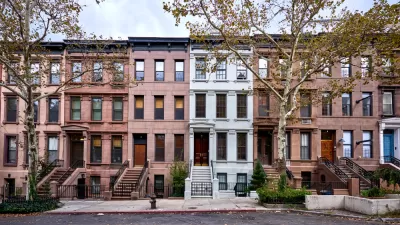The disparity between these commonly used terms can give vastly different outlooks on the housing market.

We hear the terms “average rent” and “median rent” frequently. You have probably seen headlines about how high the average rent in New York or Jersey City is. You might even think both terms can be used interchangeably. Yet do we understand what ‘average’ or ‘median’ mean?
If you remember anything from your college statistics class (and if you don’t, I don’t blame you), you know the two terms are not the same. This is an especially important distinction to make when discussing rent prices, which are at the top of most Americans’ minds at the moment. First of all, we have to understand that the average and the median of something are two different types of measurement that serve different purposes.
On one hand, the average calculates the arithmetic mean of a set of data (the set being the number of rents in the market). In this manner, we use the following formula:
If your set of data has five items, you would sum the value of those five items and divide them by 5.
On the other hand, the median of a set of data is the middle value of the set of data. In other words, if your set of data consisted of five items, you would line them up in order of size and search for the middle item — in this example, the median would be the third item in the sequence.
Why does the difference matter when talking about rents? Apart from the sake of being statistically correct, it is important to understand the difference when looking for a home or trying to understand a city’s housing market.
The thing with averages is that they can change drastically based on one item in a set. For example, the average rent in a city with thousands of low-rent units could be dragged upwards by a few exorbitantly priced units. This skews the picture of the rental market, and could fool you into thinking that the majority of rents in that city are close to the average amount.
Unlike the uncertainty of the average, the median provides information that, in my opinion, is more useful. As we know, the median is the middle item in a set of data. Translating this into the rental world, median indicates the middle rent of all the rents in the city, meaning that half the rents in the city are above the median and half are below. In a perfect world scenario, the median and the average would be the same, an evenly distributed bell curve.
The world is not a perfect place, and neither is the rental market. This is why we have different values for the median rent and average rent. New York City provides a useful example. Reports of average rents and median rents show different figures. According to Rental Markets Trends, as of 2024, the average monthly rent in New York City is $4,152, while the median monthly rent is $3,495, according to Zillow, making average rent approximately 1.2 times more than the median rent. Another example is Jersey City which had an average rent of $3,250 and median rent of $2,500. In this case, the average rent is 1.3 times more than the median rent. This indicates a concentration of high prices at the end of the spectrum, not a common denominator — not to say that $3,495 or $2,500 is affordable.
It is not crazy to think that some platforms use this difference to serve their own purposes. Making a place sound more expensive than it actually is can serve particular interests. This is not to diminish the housing crisis, but is a reminder to be cautious when reading bold headlines about “average rent costs.”
A quick online search will reveal different numbers for average and median rent, and, often, the terms will be used interchangeably — so beware. When you go apartment hunting, keep this difference in mind while doing your research. If the average rent is high, it might only mean that some very expensive units are on the market. Seek out more information on your neighborhood and you might be surprised at what you find.

Alabama: Trump Terminates Settlements for Black Communities Harmed By Raw Sewage
Trump deemed the landmark civil rights agreement “illegal DEI and environmental justice policy.”

Planetizen Federal Action Tracker
A weekly monitor of how Trump’s orders and actions are impacting planners and planning in America.

The 120 Year Old Tiny Home Villages That Sheltered San Francisco’s Earthquake Refugees
More than a century ago, San Francisco mobilized to house thousands of residents displaced by the 1906 earthquake. Could their strategy offer a model for the present?

In Both Crashes and Crime, Public Transportation is Far Safer than Driving
Contrary to popular assumptions, public transportation has far lower crash and crime rates than automobile travel. For safer communities, improve and encourage transit travel.

Report: Zoning Reforms Should Complement Nashville’s Ambitious Transit Plan
Without reform, restrictive zoning codes will limit the impact of the city’s planned transit expansion and could exclude some of the residents who depend on transit the most.

Judge Orders Release of Frozen IRA, IIJA Funding
The decision is a victory for environmental groups who charged that freezing funds for critical infrastructure and disaster response programs caused “real and irreparable harm” to communities.
Urban Design for Planners 1: Software Tools
This six-course series explores essential urban design concepts using open source software and equips planners with the tools they need to participate fully in the urban design process.
Planning for Universal Design
Learn the tools for implementing Universal Design in planning regulations.
Clanton & Associates, Inc.
Jessamine County Fiscal Court
Institute for Housing and Urban Development Studies (IHS)
City of Grandview
Harvard GSD Executive Education
Toledo-Lucas County Plan Commissions
Salt Lake City
NYU Wagner Graduate School of Public Service






























